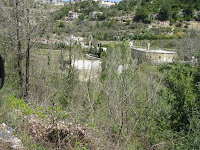
The icon pictured here is of Our Lady of Ilige (ileej), also known as Our Lady of the Maronites and the Patriarchcal icon. In more recent times, our Maronite Churches have displayed replicas of this icon in their sanctuaries. Why? Where did it come from? On my recent trip to Lebanon, I went on a pilgrimage to pray at the original site of this treasured icon and while there, discovered its interesting history.
The Church of Our Lady of Ilige is located in the village of Mayfouq in the district of Jbeil. It was built at the site of a former pagan temple, and parts of that structure are still visible in the Church building.
The word Ilige is derived from the name of the temple which was to honor the god of depth. It is claimed that Christians made the site a Church back in Apostolic times, dedicating it to the Mother of God as Our Lady of Ilige. From the the 12th to the mid- 15th century this Church was the refuge, shelter and home of our Maronite Patriarchs.
I arrived at the Church of Our Lady of Ilige on Holy Saturday, anticipating with great excitement my visit to this former residence of the Patriarchs and the sanctuary of the icon. As you can see from these photos, the church is quite small, old, and a typical stone structure of the mountain villages.



The second floor housed the residence of the patriarchs, comprised of a couple of small rooms which tell of the simplicity and austerity of their life.






As I stood facing the altar, I noticed a large painting of the Mother of God, but it was in the style of late 18thcentury Italian art with hints of Syriac Maronite symbols. There was no resemblance to the icon I was looking for.


The original icon of Our Lady of Ilige was actually buried under ten layers of paint in subsequent attempts to fix, improve, or adjust the icon over the centuries. As a result, the icon was covered over, only to be discovered in the restoration undertaken in the 1980’s. To the surprise of the Carmelite nuns assigned to the restoration, layer after layer was uncovered to reveal the original, an icon of Syriac Maronite art dating to the 10th century.
This explains why this icon has only recently appeared in our Maronite Churches. It is new to us, but one of our oldest preserved icons which belonged to the Patriarchs. Let us treasure it.
By the way, the picture I saw in the Church of Our Lady of Ilige was a reproduction of what the painting looked like before restoration. I later found out that the original icon is securely displayed at a nearby Monastery.
We do not have many pieces of our art from the early centuries due to wars, persecutions and the destruction of Churches over time. The discovery of this icon is a blessing and gift to the Maronites, as it preserves the unique style of Syriac Maronite art form.
An explanation of the significance of symbols and colors of this icon can be found on the NAM website.


The original icon of Our Lady of Ilige was actually buried under ten layers of paint in subsequent attempts to fix, improve, or adjust the icon over the centuries. As a result, the icon was covered over, only to be discovered in the restoration undertaken in the 1980’s. To the surprise of the Carmelite nuns assigned to the restoration, layer after layer was uncovered to reveal the original, an icon of Syriac Maronite art dating to the 10th century.
This explains why this icon has only recently appeared in our Maronite Churches. It is new to us, but one of our oldest preserved icons which belonged to the Patriarchs. Let us treasure it.
By the way, the picture I saw in the Church of Our Lady of Ilige was a reproduction of what the painting looked like before restoration. I later found out that the original icon is securely displayed at a nearby Monastery.
We do not have many pieces of our art from the early centuries due to wars, persecutions and the destruction of Churches over time. The discovery of this icon is a blessing and gift to the Maronites, as it preserves the unique style of Syriac Maronite art form.
An explanation of the significance of symbols and colors of this icon can be found on the NAM website.
